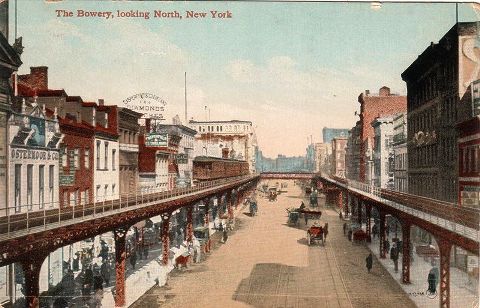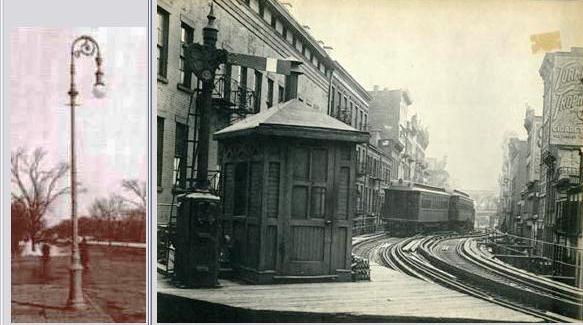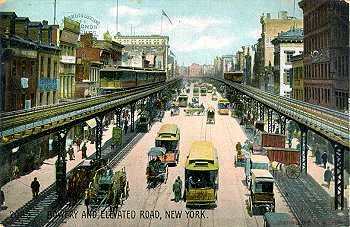Dear Donald,
In November we have a tradition of releasing just before Thanksgiving.
Please enjoy Ray’s research,
| THE 1887 BOWERY FIRE |
Ray Jerrems, Our Genealogist, Historian

Introduction
A warning to readers, this article is classified “M” for mature readers only!
This article illustrates the style of newspaper reporting in the 19th Century, using a report about a fire involving a “Nicoll the Tailor” store as an example. The article also gives insights into the operations of “Nicoll the Tailor”, the redoubtable Alexander Nicoll/Nicholl who was the great great grandfather of our Editor Donald and readers like Chick Keller, Jerry Jerrems, Cathy and the Healy brothers. His photo was in the December 2008 Journal.
Newspaper reporting in the 19th Century
Several years ago, with Sandra’s considerable assistance from the United States, I had been combing 19th Century newspapers for stories involving the Jerrems family and their relatives. Literally millions of the newspapers, from cities and towns along the east coast of USA, have been scanned and are available on several websites. This is a valuable source of information which I have drawn upon in previous Jerrems Journals.
While looking through the newspapers it struck me that the journalism in the 19th Century had a far different style to what we see in our newspapers these days. The journalism in those days was notable for its lurid phraseology, graphic detail and morbid interest in death and destruction. My impression is that people in those days took a macabre interest in the misadventures of other people which is mostly lacking these days, and the newspapers pandered to this (or perhaps they caused it?).
In Sydney (probably like most major cities) we too had the more extreme “yellow press” or “gutter press”. This was dominated in Sydney by John Norton (1858-1916) in his newspaper “The Truth”. Contrary to the newspaper’s name the notorious Norton specialised in the most scurrilous articles imaginable about the Establishment, accusing bishops and his fellow politicians of such outrageous crimes as rape and incest etc. Some of the victims sued the newspapers but most did not bother because the stories were obviously fabricated.
As I read the old newspapers I thought to myself, did our forbears read this stuff, and wondered what they must have thought of it. In my research I watched out for an article which involved the Jerrems family and also demonstrated the lurid side of the journalism.
My patience is rewarded
Finally my patience was rewarded. I found some 1887 articles describing how the “Nicoll the Tailor” store on The Bowery (in New York City) caught fire, resulting indirectly in the deaths of three men and serious injuries to seven others.
The term “The Bowery” (of Dutch origin) refers to the New York road and also to the locality (made infamous in the early 20th Century by “the Bowery Boys”). The store was on The Bowery road.
In the 1880s and ’90s the Bowery thronged with revellers. “The liveliest mile on the face of the earth,” as the street was then called, it hosted concert halls, dance clubs, saloons, theatres, and other assorted nightspots.
Nicoll the Tailor’s Bowery store took up seven building lots (ie it took up street numbers 139 to 151) (a total distance of about 60 yards/metres) and housed a retail store and a factory where mens’ suits were made. It was quite famous due to Alexander’s vigorous advertising campaigns, and was a landmark because it had electric lighting (see later).The fire damage was estimated to be a huge $100,000 (possibly $5,000,000 in today’s terms). Luckily the building was insured!
The fire received front page coverage in the New York newspapers, which were very competitive and rushed out a number of editions each day, vying for the public to buy their newspapers. Older readers will remember that the afternoon editions of our city newspapers followed this pattern until the 1970s, with editions including the “Cable Edition”, the “Extra” and the “Late Final Extra”. The city streets rang with the cries of the “paper boys” on the street corners, calling out “Read all about it. Late final extra” etc. As you strode past they dextrously put a folded newspaper under your arm with one hand and took your coins with the other. Much more evocative than the internet!
The structure of earlier newspaper reports
As older readers would also remember, newspapers were originally set up manually by a team of typesetters who used a metal block for each letter. A newspaper took time to assemble and edit. The tendency therefore was for articles in early editions to be supplemented by additional paragraphs which were added to the previous typesets as further reports of an event were received, rather than have the original text edited or completely re-written, as is done these days.
The latest report on the Bowery fire was therefore quite long-winded and repetitive, so I have merely taken extracts from it to illustrate the style of journalism used.
Elevated railways in the streets of New York
But first, some more explanations. The background to the article (necessary for you to understand the extracts) is that after the building caught fire, in an unrelated incident a train on a nearby elevated railway track stalled or temporarily broke down. Construction of these railways was commenced in the late 1860s in New York and provided a means for passengers to be carried along many New York streets above the street level , leaving the street level for pedestrians and road traffic and (in some instances) railways or tramways owned by other companies.
In 1878 an elevated railroad was built along the Bowery. The tracks were erected on each side of the street, above the sidewalks. It can be seen from the photograph of The Bowery that the impact on the street was fairly low, but in some other streets (as shown in the black and white photo) the elevated railways and their passenger platforms, signal boxes and signals completely dominated the area above the roadway. People living on the first floor of buildings in these streets would have had trains clattering past their windows at all hours of the day and night.
Although the New York Subway system was commenced in the early 1900s many of the elevated railways were retained for some years afterwards.

Dister
Disater Strikes
This was a very sad event. Returning to the newspaper story, early in the morning a train on the elevated railway stalled or broke down close to the fire engulfing the “Nicoll the Tailor” store.
After unsuccessfully waiting a while for the train to resume its journey a number of male passengers anxious to get to work on time alighted from the train and started walking along an unfenced catwalk running along the side of the railway track, intending to walk along a short distance to a nearby platform. The train was belatedly started up and as it gained speed it either knocked the men off the catwalk into the street 20 feet below or (fearing that they would be dragged under the wheels of the train) the men panicked and jumped, landing near the crowd watching the fire. The crowd thought this was wonderful, two disasters for the price of one!
Extracts from the newspaper reports
THRILLING ACCIDENT
A story of men shoved from a narrow walk high above the street by a moving train-Terrible scenes- three killed and seven badly injured.
Hundreds of people gathered around the scene of the accident…The sidewalk and street were covered in blood….
From below where the crowd was watching a SHOUT OF WARNING AROSE but too late. One, two, a half dozen men were seen falling over the edge into the street below, from which arose a frightened wail that turned into shrieks of terror and despair as man after man struck the pavement and lay mangled and bleeding….
In two minutes the plank walk was clear. Down below in the street, A SCENE OF HORROR. In a ghastly heap the men lay, some motionless, some groaning faintly, or shrieking wildly in pain and terror….The three at the bottom of the heap were dead. They had fallen head first and had smashed in their skulls, one and all. For them the dead wagon was called and they were taken to the Morgue.
What do you think of the report?
Have I made my point? Obviously it was very sad that men had been killed and injured. But what did our forbears think, reading such macabre articles, which were published far afield in newspapers owned by the same publishers? Fancy calling it “A thrilling accident”. Would your great grandpa or great great grandpa have taken the gruesome details in such newspaper accounts literally, as he perused his morning newspaper over his breakfast toast and marmalade. Or would he have taken the stories with the proverbial “grain of salt”? I rather think the latter.
But what damage was done to the building by the fire?
The building before it was burned down
The New York Times of May 7, 1879 carried an enthusiastic article about the original store:
THE TRADE OF NICOLL, THE TAILOR
Perhaps, nowhere is the revival of trade more remarkable than in the busy hive of the famous tailor, Nicoll, whose establishment on The Bowery branches out and blossoms all over the States, and even in foreign countries. One of the great attractions of the house at present is its electric lights, six of which are used on the premises, while a seventh illuminates every night that section of the Bowery in which the celebrated mart is situated, and, as a matter of course, crowds the sidewalks. The apparatus for producing the light is open to the inspection of visitors…..[the article then described the stock and the huge scale of the business]
Electric lighting
We take electric lighting and power supply for granted these days. However the supply of power for streets and households faced considerable hurdles in the late 1800s. The first hurdle was that large coal burning power stations had to be constructed, and the second hurdle was that a supply system had to be put in place. For these reasons electric lighting tended to be introduced in city centres before the suburbs. Prior to this, most cities had oil lighting and gas lighting for their streets (in New York oil lighting was started in 1761 and gas lighting in 1823). In New York the gas light stands such as the picturesque “Bishop’s Crooks” (see photo) were retained for the electric lighting.
Prior to the introduction of the city’s electricity supply the only way of obtaining electricity was by using a private generator. The entrepreneurial Alexander Nicoll was probably at a considerable advantage because he could operate a generator with the steam engine he used to run his factory’s machinery (there were no petrol engines in those days).
The building after it was rebuilt
Alexander must have received a generous insurance payout because he rebuilt the building. Once again the New York Times in October 26, 1887 provided him with a lot of free advertising:
ONE OF THE BOWERY SIGHTS
THE REFITTED AND REFURNISHED STORE OF NICOLL THE TAILOR
The most striking front on the Bowery is at 145 and 147, and is owned by Nicoll the Tailor. Mr Nicoll says it is in the old Norman style of architecture. It is certainly attractive and none who pass it do so without taking a passing glance. The woodwork is of oak, handsomely carved. The entrance is laid in tiling of unique design. The plate-glass windows are of immense size, the largest being eleven by ten and a half feet. At each of four corners are big cylindrical-shaped windows. They are said to be the largest of their kind in the country; the casting and finishing occupied two months. The American and State flags wave from the top of the building, each storey of which is of unique construction. Altogether the exterior of the establishment is of a character to attract attention, and to this Mr Nicoll does not in the least object.
The interior is fitted to correspond with the front of the building…
Is the building still there?
This is an interesting question. I have looked at photos of the garish shops and the hotel at numbers 139 to 151. They all have lots of ground floor doorways which would not have been in the old building, and the current numbers 145 and 147 (see photo) seem to be different to the description in the newspaper. I think that the old building has been completely superseded, possibly in the 1950s.
Conclusion
I hope that the numerous descendants of Alexander Nicholl have found the information about him in this article of interest. I think I prefer the modern way of reporting. What about you?
Current picture of likeness of part of old building.


